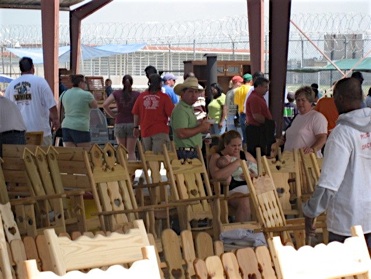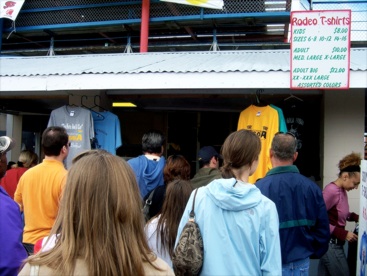10:00 a.m.
Standing just a few feet inside the area of the prison that is fenced off and designated for the event, I smell skewered meat and sugar-coated treats on a stick and the competing odors of livestock. The event smells familiar. Although I have lived in Salt Lake City for more than five years, I vividly remember the state fairs I attended while living in Florida; this event has the same look, feel, and smell of a state fair. The Angola Rodeo and Crafts Fair seamlessly transforms the grounds of the prison into a space of tourism--a public spectacle--and site of surveillance.
A woman standing next to me at the entrance, who looks to be in her mid-thirties, quickly confesses that she feels a bit “intimidated and uneasy;” later, in an email correspondence, Nancy tells me that her initial feelings “faded fairly quickly, and then it was just like any old state fair.” As we continue to share our thoughts about the event over a series of emails, as I do with nineteen other individuals I meet during my visits, she tells me that the event was “[n]othing like I imagined. It is a family event, for good or bad.” Nancy was hesitant to bring her two small children to the crafts fair and rodeo. She was unsure that it was an appropriate (read: safe) venue; a few friends convinced her to attend. A personal encounter with crime or the criminal justice system is not often sought out in the form of an embodied experience; most intentional experiences with crime are mediated through literature, television, news media, and film.
Nancy’s initial resistance to attending the rodeo and crafts fair was dictated by fear and her imagination of the prison system. Two hours before my conversation with Nancy, sitting in my rental car at the gates of the prison, I too had no idea what to expect of this experience. I was following the suggestion of a friend who thought that I would be interested in what was happening at the prison. I was compelled to make the trip to Louisiana for the same reason that almost discouraged Nancy; I wanted to have a personal encounter with the prison system, and I was fascinated by the idea that a backstage experience with the prison system could occur through tourism.
Before continuing deeper into the belly of the event, I stopped a few more tourists to talk about the reasons they traveled to Angola. I met a newly married couple from New Orleans who were making their second visit to the event; a sophomore at LSU; a retired couple from St. Francisville, LA, both were dressed for the event: wearing cowboy hats and snap-button shirts; and a freshman in high school who admitted that originally her mom had to “drag” her to the event--her attitude appeared to change by the time she spoke with me: Listen.
After spending some time at the entrance to the crafts fair I decide upon a methodical plan of attack; I would begin with the perimeter and work my way into the center of the event. The early morning mist rolling off of the Mississippi River and intermittent rain slow the crowds, but by noon it will too noisy for recording interviews. While the prison grounds are still relatively empty I want to talk with some of the men.
As I begin to weave my way through the tables of hobby crafts, leatherwork, paintings, and jewelry, and rows of indoor and outdoor furniture, I begin to sense the rhythm of the event. I start to move as though I know where to go next. One of the keys to staging a tourist attraction is to make the space legible. Because visitors to a tourist attraction only spend a fleeting amount of time in the space there a direct correlation exists between function and experience. A depoliticizing effect results from familiarity. The staging of the crafts fair, impersonating a state fair or carnival, relieves the tourist of the responsibility of experiencing the prison as a part of the architecture of discipline in the United States. Little critical reflection is required when the aesthetic of the prison mirrors a popular tourist attraction like a state fair or a public exhibition. Barbara Krishenblatt-Gimblett has shown that the tourist experience is generally staged similar to a museum, in which tourists are able to—in a familiar setting—reinforce what they already think they know about the world (xxiii). The design of the event, like all other functions of the prison, is overseen by warden Burl Cain.



